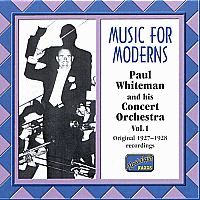 |
|
Naxos Nostalgia BSIN01952019 Whiteman, Paul / Gershwin, George / + - Music For Moderns Composer: Rube Bloom, George Gershwin, Victor Herbert; Robert Katscher, Eastwood Lane, Matty Malneck, Domenico Savino, Frank Signorelli PAUL WHITEMAN and his CONCERT ORCHESTRA
Vol. l: Original 1927-1928 recordings
Paul Whiteman: born Denver, Colorado, 28th March 1890, died Doylestown, Philadelphia, 29th December 1967.
Paul Whiteman was a well-established dance-orchestra director, indeed already a Broadway success story - and a significant proponent of "symphonic jazz" - when, in 1926, in Jazz, a statement of purpose co-written with M.M. McBride, first outlined his ideas regarding this new orchestral development. Indeed, he had been experimenting for several years in the sphere, commissioning works from "serious" composers which fused classical with jazz elements, a trend first fully developed by George Gershwin (1898-1937) in his 1922 one-act opera Blue Monday. In this experimentation, Whiteman was inestimably aided by the New York-born pianist (and ex-Los Angeles Symphony viola-player) Ferde Grofé (1892-1972). Grofé was principal arranger with the Whiteman organisation from 1920 to 1927. Whiteman had all the ideas; Grofé made them realities by transcribing them into band-parts. Together, they popularised "symphonic jazz", a modern, concert-hall amalgam scored on classical lines, sophisticated orchestrations played by men in evening dress, controlled by a man wielding a baton, with nothing left to chance: classics devised - or rather, disguised - as jazz!
Jazz, however, was not uppermost in the mind of the respectable doyen of Broadway operetta Victor Herbert (1859-1924) when, in 1923, charmed by the genial 'Pops' Whiteman, he was persuaded to write for him his Suite Of Serenades. First performed (and recorded) by Whiteman in New York a year later, these tuneful "characteristic" pieces are arguably, of all Whiteman's symphonic recordings, the most removed in style from that most seminal of all symphonic jazz compositions, Gershwin's Rhapsody In Blue. Also commissioned in 1923 by Whiteman, and arranged for jazz orchestra by Grofé and billed prominently as "An Experiment In Modern Music", this celebrated work was first performed with Whiteman conducting at New York's prestigious Aeolian Hall and later first recorded (in abridged form) in 1924 - on both occasions with the composer at the keyboard. Its enthusiastic reception overnight made the Brooklyn-born pianistsongwriter a household name and "symphonic jazz" and Whiteman instantly became synonymous fixtures of stylish society orchestral programmes. So frequently was it requested that in April 1927 the Whiteman Orchestra and the composer re-recorded the Rhapsody via the "Orthophonic" electrical process, under the baton of Victor Studios' resident conductor Nat Shilkret (1895-1982).
The range of the Whiteman symphonic recordings is eclectic. Viewed alongside well-known tunes by Tchaikovsky and Rimsky-Korsakov, Grofé's arrangement of Sea Burial by Eastwood Lane (1879-1951) may seem an unlikely, if however interesting, choice. The Brewerton (NY)-born Lane was the composer of various piano suites and two full-scale ballets. Sea Burial is a movement from his Eastern Seas (1920), one of two works in light, descriptive vein (the other was Persimmon Pucker) orchestrated by Grofé for the Whiteman Orchestra.
A number of Whiteman's best musicians also shone as arrangers. The New York-born pianist and songwriter Rube Bloom (1902-1976) was already a seasoned vaudevillian when he joined Whiteman's ranks in the early 1920s. Later a pianist with Ray Miller, the Sioux City Six and the Cotton Pickers, he was also closely associated with ensembles fronted by Joe Venuti and Red Nichols. He wrote songs for revues and his hits include "The Voice Of The Southland", "Truckin"', "Day In-Day Out" and "Fools Rush In" His solo for orchestra Soliloquy, features the Whiteman band's pianists Perella and Turner in duet. While valued members of the Whiteman line-up, Malneck and Signorelli were both prominent instrumentalists and composers each in his own right. As a teenager Frank Signorelli (1901-1975) had been a master-mind and founding-member of the Original Memphis Five. Also a member of the Original Dixieland Jazz Band, the New York-born pianist ranked among the leading white jazzmen of his day. With Malneck he wrote various standards, including "I'll Never Be The Same" and "Stairway To The Stars". A native of Newark, New Jersey, Mat "Matty" Malneck (b. 1903) was variously a composer, conductor and arranger and a skilled jazz violinist. He joined Whiteman as a player in 1926 and continued to arrange for him until 1937. Often featured in recording sessions in small ensembles with Bix Beiderbecke and Frank Trumbauer, he also recorded solos with fellow-American Carroll Gibbons in England. His best hits, all with Johnny Mercer lyrics, include "If I Had A Million Dollars", "Goody Goody" and "Love In The Afternoon". The two Malneck-Signorelli essays in modern music Midnight Reflections and Caprice Futuristic, while outstanding "symphonic jazz" compositions, also shed light upon the imaginative fiddling capacity of the dextrous Malneck.
On 3rd December, 1925 (with the New York Symphony Orchestra under Walter Damrosch), Gershwin scored and premiered his jazz-inspired Piano Concerto in F. This work was already much in vogue when, in 1928, Whiteman recorded it, with his own star pianist Roy Bargy, as soloist. (Peter Dempsey, 2000)
Price:
7,90 EUR

|
|